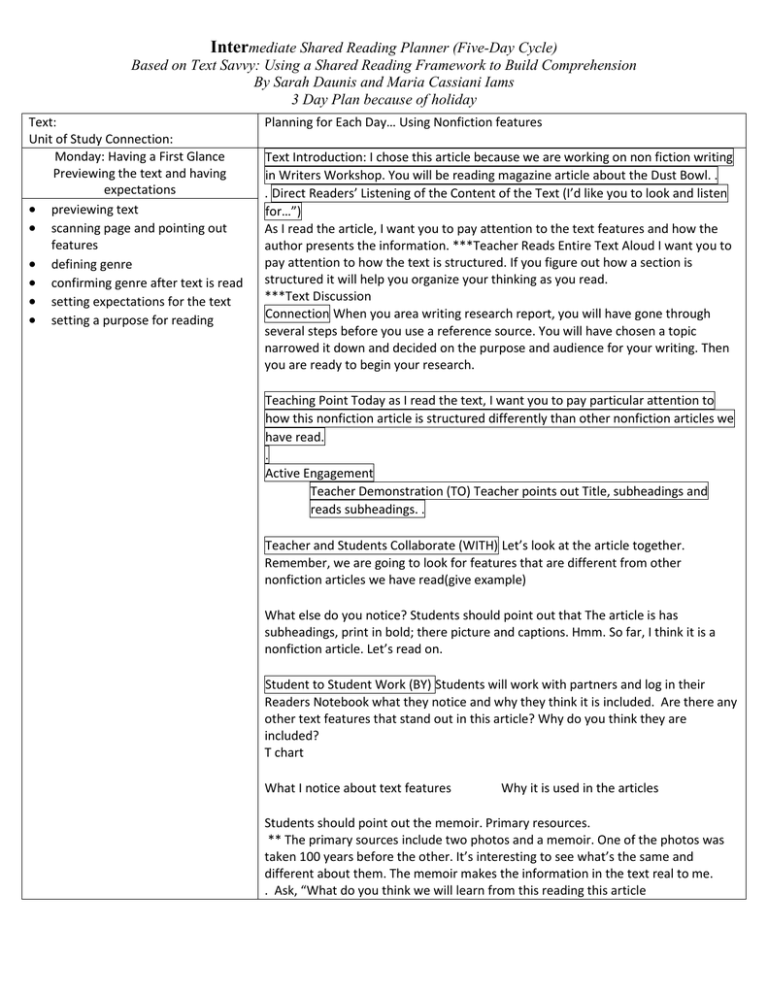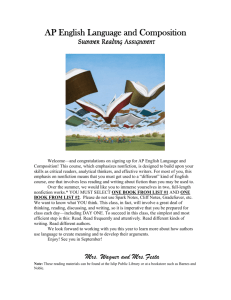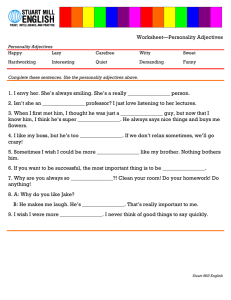Blizzard lesson plan
advertisement

Intermediate Shared Reading Planner (Five-Day Cycle) Based on Text Savvy: Using a Shared Reading Framework to Build Comprehension By Sarah Daunis and Maria Cassiani Iams 3 Day Plan because of holiday Text: Unit of Study Connection: Monday: Having a First Glance Previewing the text and having expectations previewing text scanning page and pointing out features defining genre confirming genre after text is read setting expectations for the text setting a purpose for reading Planning for Each Day… Using Nonfiction features Text Introduction: I chose this article because we are working on non fiction writing in Writers Workshop. You will be reading magazine article about the Dust Bowl. . . Direct Readers’ Listening of the Content of the Text (I’d like you to look and listen for…”) As I read the article, I want you to pay attention to the text features and how the author presents the information. ***Teacher Reads Entire Text Aloud I want you to pay attention to how the text is structured. If you figure out how a section is structured it will help you organize your thinking as you read. ***Text Discussion Connection When you area writing research report, you will have gone through several steps before you use a reference source. You will have chosen a topic narrowed it down and decided on the purpose and audience for your writing. Then you are ready to begin your research. Teaching Point Today as I read the text, I want you to pay particular attention to how this nonfiction article is structured differently than other nonfiction articles we have read. . Active Engagement Teacher Demonstration (TO) Teacher points out Title, subheadings and reads subheadings. . Teacher and Students Collaborate (WITH) Let’s look at the article together. Remember, we are going to look for features that are different from other nonfiction articles we have read(give example) What else do you notice? Students should point out that The article is has subheadings, print in bold; there picture and captions. Hmm. So far, I think it is a nonfiction article. Let’s read on. Student to Student Work (BY) Students will work with partners and log in their Readers Notebook what they notice and why they think it is included. Are there any other text features that stand out in this article? Why do you think they are included? T chart What I notice about text features Why it is used in the articles Students should point out the memoir. Primary resources. ** The primary sources include two photos and a memoir. One of the photos was taken 100 years before the other. It’s interesting to see what’s the same and different about them. The memoir makes the information in the text real to me. . Ask, “What do you think we will learn from this reading this article Tuesday Connection Yesterday we read an article about a blizzard and found out that it was different from blizzards that we have experienced. Teaching Point: Today I want you to look at the text for words that are adjectives or words that describe a noun. Active Engagement Teacher Demonstration (TO Hmm. I see in the first paragraph, the word many descries the amount of people. I am going to make a list of the nouns that I see and adjectives that describe them. Remember, not all nouns are described with adjectives. . Teacher and Students Collaborate (WITH) Students share adjectives in first section, Snow Plus Wind. Wednesday Thinking, “What might be new information for me?” Explaining, “These connections help me understand the text because…” Explaining, “These questions help me understand the text because…” Reading and thinking, “What is the text mostly about?” Reading and thinking, “What information is important and what information is interesting?” Student to Student Work (BY) Students look for adjectives. with partners, classifying them(use RNB) Connection Yesterday we. Yesterday we looked at the Blizzard and looked for adjectives to describe nouns. Teaching Point: Today we are going to use strategy of asking questions as we read to help us make sense of the text. We’re going to use the strategy we worked on before, writing in the margin-Active Engagement Teacher Demonstration (TO) Teacher first section and notes question or thoughts: Hmm. Wow this makes me wonder how people survive in weather like this. How can you be prepared? Looking at the photo, I wonder how people survived or prepared for themselves years ago. Teacher and Students Collaborate (WITH) T&T to your partner and share some questions or thoughts you have as you read the second section. Pick out a few to share. Student to Student Work (BY) Today we reviewed how to ask questions as you are reading to help makes sense of what you are reading and to push your thinking to new heights. When you are doing a research paper, this is a strategy that is important for you to do-read, question and reflects as you are reading. Now I would like you to try it with the memoir. Thursday Filling in the Picture choral reading Creating a graphic organizer creating a movie in your mind thinking about what you see in your mind’s eye creating graphic organizers you can see in your head reading and “filing” information Sketching a picture or diagram thinking, “What do I know about this topic already?” Connection Yesterday we talked about asking questions as we read and pushing our thinking Teaching Point . Today I want you to think about the emotions that were felt as the people faced the blizzard Active Engagement we will do this by reading the text chorally, pausing at the end of each paragraph to ask a question or pose a comment or thought, paragraph by paragraph Teacher Demonstration (TO) teacher models Teacher and Students Collaborate (WITH. students read together Student to Student Work (BY) students read with their partners Friday MAKE INFERENCES The author says this, but means … If I read between the lines, the author is telling me that … The clues to prove my inference are … Because of what the author said, I know that … From the clues or information the author gives, I can conclude that … I think that ____________ will happen next because the author says ____________. Connection: Yesterday we read chorally Teaching Point Today I want to teach you that as a reader, it is important to infer what the writer is saying by “reading between the liens” Active Engagement Teacher Demonstration (TO). Teacher demonstrates showing clues Teacher and Students Collaborate (WITH) teacher and students infer means in the send on section, snow blowers Student to Student Work (BY) send students with partners to think and give evidence about their inference. I think that ____________ will happen next because the author says ____________.



